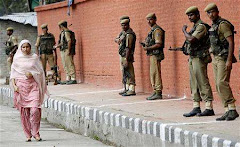In my previous post I have discussed the necessary strategies to be adopted by the state govt. in order to achieve the aim and objective of promoting the rapid growth of a market driven, knowledge based, efficient and competitive industrial sector in the state. Today let me put forth few specific suggestions and measures required to achieve this goal in terms of our technological upgradation, infrastructural development and development of our human resource.
TECHNOLOGY UPGRADATION
The first principle step towards giving impetus to the economic growth of the state has to be be technology upgradation. In particular, putting in place an institutional mechanism and a viable revenue model for the rapid technological upgradation of the small and medium industries in J&K must receive special attention. To catalyze the efforts of technology upgradation, the Government of J&K must establish a corpus like “The Technology Upgradation Fund” of Rs. 100 Crores over a period of 5 years. The fund must be administered through a Government/ Industry partnership and its deployment dictated by the logic of the market and by industry. In particular, this fund should focus on niche products and processes in the value chain of industries in which J&K has comparative advantages and reinforce best practices in technology and business. The following specific schemes and proposals must be implemented under this scheme:
(a) Interest subsidy to SSIs who avail loan from State Financial Corp. for technology upgradation and modernization;
(b) Promoting Technology Business Accelerators with the active involvement of private sector in identified potential locations in the State. Government assistance should be in the form of providing financial assistance for creation of basic infrastructure facilities subject to a ceiling of say Rs.50 lakhs per Accelerator.
(c) To establish, over the next 5 years, at least five Science & Technology Entrepreneurship Parks [STEPs] in potential districts of the State. Government assistance should be in the form of capital grants for creating basic infrastructure facilities to the extent of 25% of the cost of each STEP subject to a specified ceiling, say of Rs.25 lakhs.
(d) To assist and encourage the private sector to establish material and product testing as well as quality assurance laboratories in different districts of the State. Government assistance for establishing such laboratories and testing centres should be in the form of capital grants of 10% of the capital cost subject to a pre-specified ceiling, say of Rs.10 lakhs per Centre; and
(e) Government must encourage the SSIs to obtain ISO 9000, ISO 14000 and similar international certification with a view to promote total quality management and best practices in SSIs. Government Assistance should be in the form of meeting 50% of the cost of obtaining such certification, subject to a pre-specified ceiling, say of Rs.75, 000 per industry.
INFRASTRUCTURAL DEVELOPMENT
(a) The Government of J&K must recognize that a key parameter to make local industry globally competitive is to provide industry access to high quality industrial infrastructure at competitive prices. Towards this end the Government must establish an “Infrastructure Development Fund” with an initial corpus of Rs.100 Crores. This fund will seek to leverage the strengths - technical and financial - of major private infrastructure providers through a Public-Private partnership. The common infrastructure fund should be aimed at meeting the infrastructure needs of sector specific and location specific technology parks/industrial estates/industrial areas for the focus sectors. This corpus fund would be used to kick-start investments in common industrial infrastructure, which could be accessed by the industry.
(b) In order to fulfil its goals of developing a market driven and efficient management of industrial infrastructure, govt. should establish Industrial townships in major industrial estates/areas. The Industrial Townships will provide for management of the Industrial Infrastructure by private industry associations/user groups. The Industrial Townships are expected to allow industry to manage their own assets and ensure a high order of maintenance of the basic infrastructure like roads, power, water supply, telecommunication etc. within the Industrial Estate/Industrial parks. The ill effects of bad wheather conditions that prevail in the valley during winter season, on the industrial activity due subsequent closure of the Jammu-Srinagar highway can be countered to a large extent by opening up of alternative routes like Mughal Road and Singthan-Kishtwar Road. Opening up other alternative roads for large scale trade like Muzaffarabad Road, Kargil-Skardu and Poonch-Rawalakot Road besides the traditional silk route will also alleviate the jitters of bad wheather conditions over industrial activity during winter season.
(c) Industrial Areas Development Board must be constituted that will act as a key Govt. agency to develop sector specific/location specific industry parks over the next five years. This Board may also promote the following:
i) Agro Food Processing Parks at Srinagar, Baramula, Kupwara, Budgam, Anantnag, Pulwama, Doda, Rajouri, Jammu, Udhampur and Kathua.
ii) A Special Economic Zone (SEZ) in a suitable location of each division.
iv) An Export Promotion Industrial park each in Jammu and Srinagar.
v) A knowledge park each, dedicated to IT, Biotechnology and related industries near Srinagar and Jammu.
(d) In order to ensure that cost of land to the entrepreneur is not exorbitant, wherever Government land is available, the same will have to be transferred to the proposed Industrial Area Development Board (IADB) free of cost so that this could be used as a cushion to reduce the price of land acquired and developed by IADB for allotment to entrepreneurs;
(e) Govt. will have to take steps to ensure uninterrupted and quality power to the Industrial sector by establishing dedicated sub-stations of adequate capacity in all major Industrial Areas/Estates over the next five years; and
HUMAN RESOURCE DEVELOPMENT
a) Developing a large skill/knowledge based workforce is fundamental to a self-sustaining industrial sector. Recognising this imperative, the Govt. must, with the active participation of Industry, revitalise the network of Artisan Training Institutes, the District/Industrial Training Institutes and Polytechnics to upgrade the quality and skill of manpower employed by SSIs. This effort should receive impetus from industry and established academic institutions of the state.
(b) As part of the initiative to promote a strong entrepreneurial base, the Government will have to strengthen the Entrepreneurship Development Institute of J&K. The objective will be to utilise the creative capabilities of the local people particularly in less industrialised areas. EDI must be encouraged to collaborate with recognised National/International organisations involved in Entrepreneurship Development. Government of J&K must seek to develop EDI into a Centre of excellence in Entrepreneurship Development, Business Management and Training.
(c) In order to encourage micro enterprises in rural and backward areas the Government of J&K must chalk down a suitable programme of establishing Rural Development and Self-Employment Training Institutes in all Districts of the State. The Management of these institutions should be largely through private initiative to meet the needs of local industry.
The first principle step towards giving impetus to the economic growth of the state has to be be technology upgradation. In particular, putting in place an institutional mechanism and a viable revenue model for the rapid technological upgradation of the small and medium industries in J&K must receive special attention. To catalyze the efforts of technology upgradation, the Government of J&K must establish a corpus like “The Technology Upgradation Fund” of Rs. 100 Crores over a period of 5 years. The fund must be administered through a Government/ Industry partnership and its deployment dictated by the logic of the market and by industry. In particular, this fund should focus on niche products and processes in the value chain of industries in which J&K has comparative advantages and reinforce best practices in technology and business. The following specific schemes and proposals must be implemented under this scheme:
(a) Interest subsidy to SSIs who avail loan from State Financial Corp. for technology upgradation and modernization;
(b) Promoting Technology Business Accelerators with the active involvement of private sector in identified potential locations in the State. Government assistance should be in the form of providing financial assistance for creation of basic infrastructure facilities subject to a ceiling of say Rs.50 lakhs per Accelerator.
(c) To establish, over the next 5 years, at least five Science & Technology Entrepreneurship Parks [STEPs] in potential districts of the State. Government assistance should be in the form of capital grants for creating basic infrastructure facilities to the extent of 25% of the cost of each STEP subject to a specified ceiling, say of Rs.25 lakhs.
(d) To assist and encourage the private sector to establish material and product testing as well as quality assurance laboratories in different districts of the State. Government assistance for establishing such laboratories and testing centres should be in the form of capital grants of 10% of the capital cost subject to a pre-specified ceiling, say of Rs.10 lakhs per Centre; and
(e) Government must encourage the SSIs to obtain ISO 9000, ISO 14000 and similar international certification with a view to promote total quality management and best practices in SSIs. Government Assistance should be in the form of meeting 50% of the cost of obtaining such certification, subject to a pre-specified ceiling, say of Rs.75, 000 per industry.
INFRASTRUCTURAL DEVELOPMENT
(a) The Government of J&K must recognize that a key parameter to make local industry globally competitive is to provide industry access to high quality industrial infrastructure at competitive prices. Towards this end the Government must establish an “Infrastructure Development Fund” with an initial corpus of Rs.100 Crores. This fund will seek to leverage the strengths - technical and financial - of major private infrastructure providers through a Public-Private partnership. The common infrastructure fund should be aimed at meeting the infrastructure needs of sector specific and location specific technology parks/industrial estates/industrial areas for the focus sectors. This corpus fund would be used to kick-start investments in common industrial infrastructure, which could be accessed by the industry.
(b) In order to fulfil its goals of developing a market driven and efficient management of industrial infrastructure, govt. should establish Industrial townships in major industrial estates/areas. The Industrial Townships will provide for management of the Industrial Infrastructure by private industry associations/user groups. The Industrial Townships are expected to allow industry to manage their own assets and ensure a high order of maintenance of the basic infrastructure like roads, power, water supply, telecommunication etc. within the Industrial Estate/Industrial parks. The ill effects of bad wheather conditions that prevail in the valley during winter season, on the industrial activity due subsequent closure of the Jammu-Srinagar highway can be countered to a large extent by opening up of alternative routes like Mughal Road and Singthan-Kishtwar Road. Opening up other alternative roads for large scale trade like Muzaffarabad Road, Kargil-Skardu and Poonch-Rawalakot Road besides the traditional silk route will also alleviate the jitters of bad wheather conditions over industrial activity during winter season.
(c) Industrial Areas Development Board must be constituted that will act as a key Govt. agency to develop sector specific/location specific industry parks over the next five years. This Board may also promote the following:
i) Agro Food Processing Parks at Srinagar, Baramula, Kupwara, Budgam, Anantnag, Pulwama, Doda, Rajouri, Jammu, Udhampur and Kathua.
ii) A Special Economic Zone (SEZ) in a suitable location of each division.
iv) An Export Promotion Industrial park each in Jammu and Srinagar.
v) A knowledge park each, dedicated to IT, Biotechnology and related industries near Srinagar and Jammu.
(d) In order to ensure that cost of land to the entrepreneur is not exorbitant, wherever Government land is available, the same will have to be transferred to the proposed Industrial Area Development Board (IADB) free of cost so that this could be used as a cushion to reduce the price of land acquired and developed by IADB for allotment to entrepreneurs;
(e) Govt. will have to take steps to ensure uninterrupted and quality power to the Industrial sector by establishing dedicated sub-stations of adequate capacity in all major Industrial Areas/Estates over the next five years; and
HUMAN RESOURCE DEVELOPMENT
a) Developing a large skill/knowledge based workforce is fundamental to a self-sustaining industrial sector. Recognising this imperative, the Govt. must, with the active participation of Industry, revitalise the network of Artisan Training Institutes, the District/Industrial Training Institutes and Polytechnics to upgrade the quality and skill of manpower employed by SSIs. This effort should receive impetus from industry and established academic institutions of the state.
(b) As part of the initiative to promote a strong entrepreneurial base, the Government will have to strengthen the Entrepreneurship Development Institute of J&K. The objective will be to utilise the creative capabilities of the local people particularly in less industrialised areas. EDI must be encouraged to collaborate with recognised National/International organisations involved in Entrepreneurship Development. Government of J&K must seek to develop EDI into a Centre of excellence in Entrepreneurship Development, Business Management and Training.
(c) In order to encourage micro enterprises in rural and backward areas the Government of J&K must chalk down a suitable programme of establishing Rural Development and Self-Employment Training Institutes in all Districts of the State. The Management of these institutions should be largely through private initiative to meet the needs of local industry.




















































Recession provides opportunity to small-scale industrial units in Punjab
ReplyDeleteCourtesy: ANI (Yahoo news)dt Tue, Feb 10th, 2009
Mohali, Feb 10 (ANI): The financial meltdown may have wiped off many job opportunities across the globe, yet some small industrial units in Punjab are not only surviving but are also kicking.
Making an opportunity out of crisis, the small units manufacturing automobile parts and engineering goods grabbed low volume orders placed before them. The bigger units are trimming down their production and focusing on cost cutting. It has shifted the orders towards the small-scale sector in the state.
"Large-scale industry cannot operate on low volumes so either they have closed some of their units or have reduced their production. Small units are getting some benefit because of this, said B S Anand, President, Mohali Industries Association.
Although very smaller units are reaping rich dividends despite economic slowdown, the owners of such units feel that innovation is the key to success even in a demand-starved economy.
Experts say that the companies strategizing in terms of adding new product lines and re-deployment of workforce will be the ones to survive the economic slowdown.
"These small scale industries are the companies which are proving tangible services to be consumed by the people for which there cannot be any decline," said A.K Vashisht, industry expert.
Over 1,200 small-scale and large-scale units employing more than 100,000 people operate in Mohali. Most of these manufacture engineering goods and automobile parts. (ANI)
CM invites India Inc to invest in JK
ReplyDeleteFICCI assures CM power-intensive industries group will explore possibilities of future investment
Courtesy: Daily Greater Kashmir dt. Feb. 13th, 2009New Delhi, Feb 12: Appealing the Indian industry to come to J&K for investment, the Chief Minister, Omar Abdullah asked them to reestablish and revive the relationship they had for long with the state, even as FICCI assured him that the power-intensive industries group will explore possibilities of future investment in the State.
Addressing the 81st Annual General Meeting of Federation of Indian Chamber of Commerce & Industry (FICCI), here this morning, the Chief Minister said the State has witnessed the most peaceful elections in the last two decades and people have ensured the success of the democratic process by huge participation. He said people have yearned for change and the State wants to be known for events other than violence. For this, he called for the support of the Corporate sector.
Chief Minister of Delhi, Mrs. Sheila Dixit and Chief Minister of Madhya Pradesh, Shivraj Singh Chavan also attended the meeting, besides a galaxy of industry captains from all across the country.
Enumerating the investment potential of the State, Abdullah said while Jammu can be described as the capital of small & medium enterprises, Kashmir holds potential for tourism, agro-based, IT and outsourcing industries.
He said only two days ago, he inaugurated the BPO of the ESSAR Group in Srinagar, adding that by investing in sectors like health, education and power, the industry shall not only be earning profits but also fulfilling its promise of social responsibility towards the State as well. He also said he would be meeting the Prime Minister to talk about incentives for investing in Jammu and Kashmir.
The CM hoped that the LoC in Kashmir becomes Line of Commerce and said he will be taking the connectivity and financial problems coming in the way of this trade with the Centre. He said after the Lok Sabha elections are over, he would start a process of internal dialogue in the State.
On the efforts of the Government, Abdullah said infrastructure is the primary focus of the present coalition, adding many infrastructure projects are in the pipeline including the historical rail project. He said the first flight from Srinagar Airport will take off on Saturday.
On the occasion, the Chief Minister interacted with delegates and answered their queries. He also invited FICCI to visit the State and experience the changed atmosphere.
Thanking the Chief Minister for his presence and gesture, the Director General, FICCI, Dr. Amit Mitra assured him that his organization will explore investment opportunity with the power-intensive industries group. He also said that the study on Food Processing industry conducted by FICCI will be presented to Abdullah soon.
Dr. Mitra also announced that FICCI will hold its next retreat of CEOs of industry later this year in Kashmir.
Bringing outside investment
ReplyDeleteDaily Rising Kashmir
Thursday, 12 February 2009
It is good to attract outside state investment in J&K
The initiative from Essar Group to start their Business Process Outsourcing venture in the trouble torn state is a
beginning well made. The company intends to invest a corpus of Rs 100 crore to start the enterprise. Much more than
this was a statement form the State Chief Minster about the limited role of government in providing employment to the
educated unemployed in the changing environment.
The CM in his statement said that the government cannot provide government jobs to the youth of the State and that the
State government has to facilitate the Industrialists of India to start their ventures here. The solution to end
unemployment here is to allow outside State investors to invest in Kashmir. The BPO is scheduled to start after three
months and will generate employment for 2000 youth of the State. Even the officials of the company admitted that
Kashmir has a good talent pool that can utilized to good ends. Essar has expressed more investment interest within the
State of J&K and plan to launch group’s mobile service, Vodafone, besides taking up hydroelectricity projects.
The Chief Minster during his recent Mumbai visit also invited other industrialists of India to make J&K their preferred
investment destination. Adani group and many more also have expressed their willingness to invest in the State. Earlier
in 2006 investment interest was evinced by Telecom major Bharti group, hotelier Lalit Suri, Kolkata based Peerless group
and many more groups. This as per the government figures would bring in an investment worth more than Rs 1000 crore
to the State, but all that didn’t mature later. Even “Invest Jammu Kashmir Summit” did not bring
much to this trouble torn State. The then Chief Minster had invited the industrial fraternity of India to contribute in socioeconomic
development of the State to achieve the twin gains of economic prosperity for the State and good returns for
the shareholders of companies that invest in J&K. One of the reputed industrial bodies Federation of Indian Chambers of
Commerce and Industry also proposed to build an investment climate in Handicraft and Handloom sector of the State by
setting up spinning mills to spin bulk quantity of good quality yarn, establishing dyeing, calendaring and finishing facilities
for woolens, and marketing of fashionable items like Pashmina shawls and accessories but again the proposal seems to
have aborted much before its delivery. Anyways, let us not count the past and try to look forward as attracting private
investment has to be a priority with the government.
What is noteworthy also is a statement from the Minister for Industries and Commerce that the investment decision took
only 20 days and that 15 Kanals of land were made available by the Industries Department within a span of just 48
hours. It would be much more worthwhile if this electrifying speed in allotting land and investment would be made
available to local entrepreneurs who have to run from one door to another in the bureaucratic set up to even establish a
small business venture. Let us hope that this time government initiates some measures in this regard.
Employability and Higher Education
ReplyDeleteDaily Rising Kashmir
Thursday, 12 February 2009
Last Updated Thursday, 12 February 2009
We need to connect education with market
Dr. Farooq Ahmad Peer
The word employability, in the context of higher education, implies ability to be employed in a job which gives sustenance
to a person’s own life and at the same time generates economic and financial benefits for his country and society.
The concept of key employability skills provides a bridge between education and work. In a dynamic knowledge-based
economy the job-specific skills that workers need can not be readily predicted, and are subject to continuous change. It is
important, therefore, to develop capacity to continually adopt and upgrade higher education which in turn creates generic
skills in the learners and fits them at any workplace.
The two greatest concerns of the society today are to find good workers and train them to achieve the required standard
of development. As Atkins puts in Teaching in Higher Education, “Education and training should enable people in
an advanced society to compete with the best in the world.” It is strongly believed nowadays that employability
skills are those basic skills necessary for getting, keeping, and doing well on a job. These are the skills, attitudes and
actions that enable workers to get along with their able workers and supervisors and to make sound, critical decisions.
Unlike occupational or technical skills, employability skills are generic in nature rather than job specific and cut across all
industry types, business sizes and job levels from the entry level worker to the senior-most position. Employability skills,
while categorized in many ways, are usually divided into three skill sets; Basic academic skills, Higher-order thinking
skills and Personal qualities. Although the academic skill level required by some entry-level jobs may be low, basic
academic skills are still essential for high job performance. In order to achieve this goal, higher education can burnish the
academic skills and enable the learner to develop the power to comprehend the information about the latest
developments in the global economy. It can enable them to have the reading and communication skills and acknowledge
them with the basics of job requirements.
At present the need of higher education has grown and there is no doubt that efforts are made to make it relevant and
also cope up with the challenges, it is facing. However, it is felt that the colossal challenge which it is combating is the
employment opportunities. The requirements of education sector have grown several fold during the last few decades
with a view to enable it to respond adequately to the ever increasing pressure on education. However, there has been
little effort during these decades to bring about a reasonable parity between the products of this huge mission and the
human resource needs of the country and our state particularly. It is evident that there has been mismatch between the
educational opportunities on the one hand and employment opportunities on the other. increasing day by day and it has exceeded lacs in the state. The most agonizing concern is that though we are talking
about promotion of education in the nook and corner of the country but no attention is shown how to absorb the educated
youth so that they are saved from the frustration and depression from which they suffer after completing their degrees.
There is an urgent need to create a frame work and programme of action to reduce the degree of mismatch between
higher education and man- power needs of the society. The present situation calls for special efforts and programmes in
the higher education sector to develop human resources compatible with the requirements of contemporary society, on
the one hand, and, on the other, to evolve mechanisms for the generation of new employment opportunities. While
manpower requirements are crucially important, it should not be forgotten that the universities can not be mere suppliers
of degree holders who afterwards become a burden for themselves and the society. There has, however to be a close
interaction between the universities and the employment sector with the aim to minimize the gaps between the skills
offered by the institutions and those required by employers. We find that thousands of graduates, post graduates,
doctoral degree holders, engineering degree holders, medical degree holders are coming out of the universities with no
employment possibilities. We witness these degree holders are in lacs at present and their future seems to be bleak. The
higher education system needs to formulate policies and it can not ignore this burning issue and keep educated and
talented human resources unutilized. The situation calls for the formulation of a planned strategy, which is socially
acceptable, with a view to ensure proper human utilization. While considerable strides have been made to expand higher
education, which has, to a great extent, covered the deprived sections of the society also, but it is equally necessary to
strengthen centers of employment and self- reliance. However, it is dismaying that no concrete effort has been made so
for in this direction of analyzing the employment spectrum of these holding high degrees. Our education policy makers
have a moral responsibility not only to expose talent and promote excellence but to devise the system of higher
education in such a manner which creates maximum employment opportunities for these talented young men who come
out in thousands every year. This kind of education is sure to infuse spirit of encouragement and also a spirit to serve
best to the interests of the society. Therefore, it should introduce vocational courses in arts, commerce, agriculture,
science, medicine, etcetera so that they become productive for employment. The educational system has the
responsibility to educate the people that their bread and butter is not confined to Government employment only but they
should avail opportunities which the government introduces in the name of self—employment schemes. To
address unemployment in rural areas, educationist and policy makers have the duty to guide the government to
introduce subjects which deal in rural industrialization so that awareness is created among the youth of such areas to opt
for these opportunities. Besides, subjects in Soil Conservation, Aforestation, Electrification, Dairy and Poultry Farming,Horticulture, Textiles, Welding, Computer Application, Fabrication, Sales Management, and many other subjects
introducing trades and professions sought by the employment market need to be brought into focus. The educationists
have to change the traditional course spectrums so that we are able to run with the times. It is a clear fact that our
educational system today is not effectively linked to social and economic development and is providing education which
is not connected to the present needs. We need to take into account the developing situations and employment
opportunities in our society and also need to give proper direction to our system of education. The present system of
education is only capable of producing a mass of educated unemployed persons with a little hope of better future. We
have to realize that imparting knowledge is not an end in itself but only a means to an end. The end is that we should sub
serve the values of our society and enable the youth of our country and state to fit themselves to gainful employment.
Before any effort is expended on this venture, it would be wise to ensure that the conception of employability skills is
sufficiently broad to be compatible with the international developments and to meet the range of needs of individuals and
employers. It must also be clearly focused that a coherent construct, comprising the most important elements of
employability, is being assessed. It becomes obligatory on the policy makers of higher education to understand the
changing world scenario on employability front and in this regard it becomes necessary to understand the changes which
have taken place among EU Member countries.
In Germany and Austria there is substantial separation between general academic and vocational education streams and
in this regard a study and consideration needs to be taken as to how this kind of approach can help in creating
employability. In Australia, employability schemes have moved more rapidly towards a market-oriented, demand-led
education and training system and one of the key policy mechanisms for strengthening the linkages between education
and the labour market has been the attempt to embed key employability skills more deeply in curricula and student
assessment
Writer is head department of English, A.S. College Srinagar. He can b emailed at Farooq_peer@yahoo.com